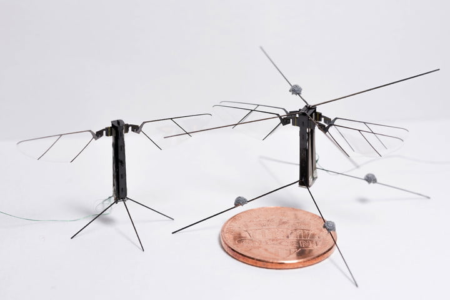May 28, 2019 – A team of engineers at the University of Southern California (USC) has designed a 95-milligram (0.0033 ounces) flying robot no bigger than a U.S. penny. What’s its purpose? It could have many but its most critical use may be as a pollinator of plants we grow away from Earth.
This is not the first attempt to create a robot substitute for bees. In my past research I have come across the RoboBee developed by engineers at Harvard, and about work on pollinating flying robots in Japan.
What has inspired this type of invention? One thing is the threat to honey bees from Colony Collapse Disorder, a problem that has seen bee populations plummet globally. The second is the collapse in insect populations recently revealed in a United Nations’ report. And third is the challenge of micro gravity in space and low-gravity environments such as on the Moon and Mars that would impact insect pollinators negatively.
What makes this new artificial flying insect substitute, the Bee+, more like a real insect than any previously designed? The Southern California team built it with four wings, unlike RoboBee which has only two. That extra pair makes Bee+ fly like the insects it was designed to emulate.
At present, there is a limitation to Bee+. It needs an external power source and as a result is tethered, a major limitation. But the USC team is developing actuators with the assistance of a National Science Foundation grant that is focused on achieving maneuverable, autonomous, untethered, insect-scale flight.
The team is working on catalytic artificial muscles to achieve this, using fuel-powered, shape-memory-alloys that generate heat to induce material phase transitions to create powered, stable, aerodynamically controllable flight. Critical to the research is the latter function will be control, the ability to fly where and when it wants and achieve whatever task it is asked to do.
And just what do the inventors of Bee+ have in mind?
- Primarily to be used to pollinate plants in environments where natural pollinators will not be able to go.
- To become explorers of off-world environments such as the planets and moons of our Solar System.
- To exhibit swarm behaviour and apply it to missions here on Earth such as reconnaissance, search and rescue.
Nestor Perez-Arancibia, USC professor in the Department of Aerospace and Mechanical Engineering, is team leader in the development of Bee+. His current work includes the Bee+ micro flyers project which also requires the development of controlling algorithms for this tiny robot, new microfabrication techniques needed to build Bee+, and soft robotic actuators that eventually will allow Bee+ to fly untethered.
Perez-Arancibia believes the other-world application for the flying robot would be one of the most exciting. He recently told Digital Trends, “I would like to see our robots flying on Mars and Titan.” He added further, “I believe that we can create ant-inspired colonies of explorers in which each member has unique capabilities and can perform specialized exploring tasks, [taking] geological samples, [measuring] the gases in atmospheres, et cetera.”









